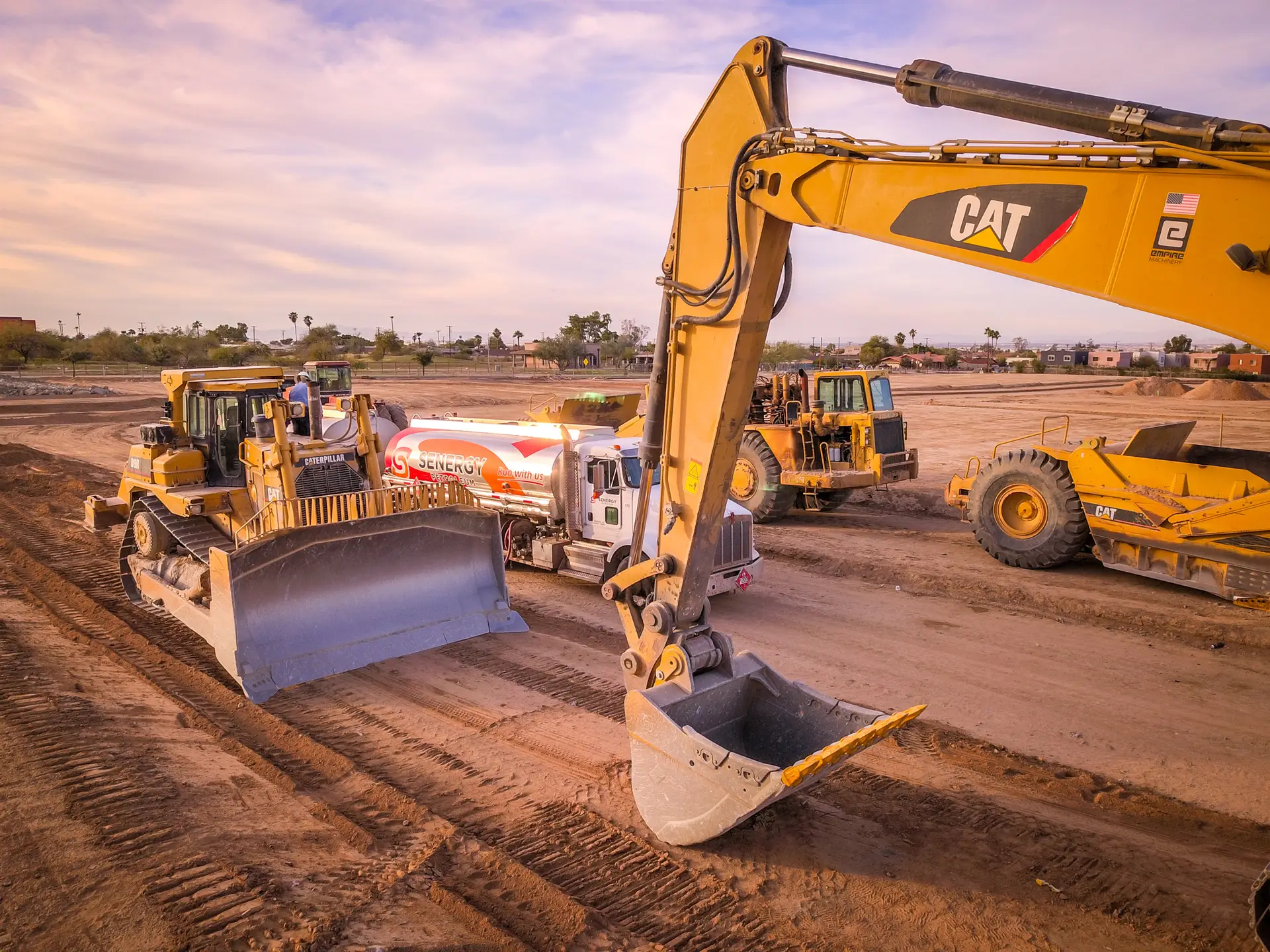Key Fluids and Lubricants Every Construction Fleet Should Stock
Managing a construction fleet requires more than routine service—it requires choosing and managing the right fluids. This includes engine oils, transmission and gear oils, hydraulic fluids, and cooling solutions. These products keep heavy equipment operating reliably under constant stress, high loads, and harsh conditions. A strong fluid program does more than schedule occasional changes; it matches each fluid’s type and grade to the specific demands of every machine.
Properly maintaining fleets and stocking the appropriate fluids reduces breakdowns, minimizes unexpected downtime, and maximizes uptime. For example, hydraulic systems operating in high-heat environments require fluids that maintain viscosity under elevated temperatures and pressure. Planning your construction fluid inventory from the start ensures each machine receives the right fluids to support consistent performance and extend service life.
Engine Oil: A Critical Component of Construction Fleet Performance
Engine oil is the most used—and one of the most important—fluids in construction equipment. Heavy-duty machines run long hours at full load, making high-quality lubricants essential for performance and longevity. Keeping oil stocked and monitoring its condition helps prevent downtime, improve reliability, and protect critical engine components. Treating engine oil as a key part of your maintenance plan directly supports fleet productivity and equipment life.
Transmission and Gear Fluids: Protecting Your Construction Fleet
While engine oil gets most of the attention, a fleet’s driveline needs equal care. Transmissions, gearboxes, final drives, and differentials rely on high-performance lubricants built for shock loads, gear contact, and wet-brake systems. Choosing the correct transmission and gear oils is essential—fluids must protect under heavy loads yet flow well during cold starts. Many manufacturers require specific formulations, and using the wrong type can void warranties or lead to premature failures. Warning signs like gear noise, overheated housings, or contaminated oil signal immediate service needs. Proper planning, stocking the right oils, and managing used fluids help ensure reliability, reduce downtime, and prevent costly repairs.
Hydraulic Fluids: Ensuring Reliable Operation
Hydraulic fluids are critical in loaders, excavators, cranes, and other construction machinery, providing sealing, lubrication, and cooling for high-pressure components. Selecting the right hydraulic fluid requires careful consideration of viscosity, anti-wear additives, filterability, and compatibility with system seals and pressures. Improper fluid selection or contamination—commonly from dirt or water—is a leading cause of hydraulic system failures in construction equipment.
The more complex the machinery, with multi-circuit hydraulics and multiple actuators such as buckets, boom motors, swing motors, and travel motors, the more essential proper fluid management becomes. A fleet maintenance plan should include a dedicated inventory of hydraulic fluids suited to operational conditions and regular analysis of fluid samples. This approach protects expensive hydraulic components, minimizes downtime, and ensures construction projects stay on schedule.


Greases, Specialty Oils & Construction-Specific Fluids
Beyond major fluids, construction fleets also need greases and specialty oils built for heavy equipment. This includes chassis grease, UTTO, final-drive oil, compressor oil treatments, and cooling additives. Greases protect bearings, pins, and bushings from harsh operating conditions, while products like multigrade UTTO can cover multiple systems where approved. Other specialty formulations—such as low-ash oils for Tier 4 engines or high-viscosity gear oils for cold climates—meet specific equipment needs. Keeping these products stocked supports proactive maintenance, speeds up repairs, ensures proper lubrication, and reduces downtime caused by missing or incorrect fluids.
Effective Storage and Management of Construction Fluids
Choosing the right fluids is only half the job—proper storage and management are just as important. Fluids should be kept in clean, dry, temperature-controlled areas, clearly labeled, and rotated using a FIFO system. Preventing contamination is essential, which means sealed lids, dedicated pumps, and clean handling conditions. Keeping detailed service records and using oil analysis software helps monitor fluid condition and plan maintenance. When fluid inventory is treated as a core part of the maintenance program, fleets can reduce losses, prevent misuse, and maintain reliable uptime.
Adapting to Trends in Construction Fluids and Fleet Maintenance
The construction fluids and heavy equipment lubricants landscape is evolving, and fleets that stay ahead benefit from increased efficiency and reliability. Recent developments include synthetic hydraulic fluids, advanced oil analysis and filtration techniques, and IoT sensors for real-time fluid monitoring. Equipment manufacturers are also specifying lower-viscosity oils and more efficient machines, requiring fluid inventories to adapt accordingly. Leveraging digital tools such as predictive analytics, OEM specification updates, and automated reorder systems supports proactive inventory management. By monitoring these trends and updating fluid programs rather than relying on legacy products, construction fleets can increase equipment resilience, reduce downtime, and achieve higher returns on investment.
Why the Right Fluids Matter
In summary, establishing a strong foundation for construction fluids and heavy equipment lubricants goes far beyond purchasing oil. It requires selecting the right products, stocking and storing them properly, and integrating fluid condition monitoring into maintenance plans while preparing for future advancements. For construction fleets, this approach reduces downtime, extends equipment life, and strengthens long-term cost control. When the right fluids are consistently used and managed, the fleet benefits from greater reliability, improved uptime, and enhanced operational efficiency.

